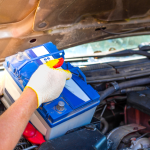As the temperature rises and summer heat settles in, car owners everywhere face a common concern: overheating. Nothing can dampen a sunny day drive quite like the sight of your temperature gauge creeping into the red zone. Fortunately, with a little care and awareness, you can safeguard your vehicle against the sweltering heat.
In this article, we’ll explore some practical tips to help prevent your car from overheating during those scorching months. From routine maintenance checks to smart driving habits, these friendly and easy-to-follow strategies will keep your engine cool, ensuring that your journeys remain smooth and enjoyable. Let’s dive in and keep your car running like a champion, no matter how high the mercury climbs!
Table of Contents
- Understanding the Causes of Overheating in Hot Weather
- Essential Maintenance for Your Cooling System
- Smart Driving Habits to Keep Your Engine Cool
- Emergency Measures to Take If Your Car Starts to Overheat
- Q&A
- Key Takeaways

Understanding the Causes of Overheating in Hot Weather
Hot weather can be a real challenge for your vehicle, leading to overheating if not properly managed. The primary culprit behind this issue is typically the cooling system, which relies on a variety of components working harmoniously to maintain optimal engine temperatures. When temperatures rise, the engine’s workload increases, putting extra strain on the radiator and coolant. If the coolant is low or the radiator is obstructed, the engine can quickly reach dangerous heat levels. Other factors, such as a malfunctioning thermostat or a worn-out water pump, can exacerbate the situation, making it crucial to keep an eye on these components during high temperatures.
There are several preventative measures you can take to minimize the risk of overheating in your car. Regular maintenance is key, including checking coolant levels and ensuring there are no leaks in the system. Furthermore, conducting a routine inspection of the radiator and hoses can help identify potential blockages or wear. To ensure that your car remains in peak condition during hot weather, consider the following tips:
- Keep the radiator clean: Remove any debris that may impede airflow.
- Change the coolant: Flush and replace it according to your vehicle’s manual.
- Monitor tire pressure: Under-inflated tires can generate extra heat.
- Park in shade: This can help maintain a cooler temperature inside the engine.
Read More: Winter Car Care Tips

Essential Maintenance for Your Cooling System
To keep your vehicle’s cooling system in top shape during scorching summer days, regular maintenance is paramount. Start by checking the coolant level and ensuring it’s topped up to the manufacturer’s specifications. This fluid not only absorbs heat but also protects against corrosion and freezing. Moreover, inspect the radiator, looking for any signs of leaks or clogs that could impede its efficiency. A clean radiator is crucial for optimal airflow, so consider flushing it periodically to remove any built-up debris.
Additionally, pay attention to the thermostat and water pump, as these components play a significant role in regulating your engine’s temperature. If you notice any fluctuation in temperature readings or strange noises from the water pump, it may be time to replace them. Don’t forget to examine the hoses and belts for wear and tear; cracked or frayed hoses can lead to leaks and overheating. Regularly servicing these elements can save you from unexpected breakdowns and costly repairs down the line:
| Component | Check Frequency | Signs of Trouble |
|---|---|---|
| Coolant Level | Monthly | Low Level |
| Radiator | Every 6 months | Leaks or Clogs |
| Thermostat | Yearly | Temperature Fluctuations |
| Water Pump | Every 2 years | Unusual Noises |
| Hoses and Belts | Every 6 months | Cracks or Frays |

Smart Driving Habits to Keep Your Engine Cool
Maintaining optimal engine temperature is vital for performance and longevity, especially during hot weather. Avoid rapid acceleration and hard braking, as these driving habits can lead to increased engine heat. Instead, adopt a smooth driving style by gently accelerating and decelerating. This not only keeps the engine cooler but also improves fuel efficiency. Utilizing your vehicle’s air conditioning wisely can also contribute to engine comfort. While it may be tempting to crank up the AC, doing so strains the engine. Instead, consider using the vehicle’s ventilation system to circulate air, or if appropriate, opening the windows for a breeze.
Additionally, routine vehicle maintenance is essential to prevent overheating. Regularly check and maintain your coolant levels, ensuring your engine has adequate fluid. A great way to monitor your coolant system is through a simple visual inspection. Here’s a quick reference for checking your vehicle’s coolant status:
| Coolant Levels | Actions to Take |
|---|---|
| Low | Refill coolant and inspect for leaks. |
| Normal | Continue regular monitoring. |
| Overheating | Pull over immediately and allow to cool. |
Lastly, keeping your car clean, especially the radiator and grill, can enhance airflow and cooling efficiency. Debris and dirt can block airflow, causing your engine to run hotter than it should. Try to wash your car regularly, particularly in the summer months, to ensure optimal performance.

Emergency Measures to Take If Your Car Starts to Overheat
In the unfortunate event that your vehicle begins to overheat, acting swiftly and calmly can save both your engine and your sanity. Firstly, turn off your air conditioning immediately and switch on the heater to its maximum setting. This can help dissipate some of the heat away from the engine. Next, pull over to a safe location as soon as it’s safe to do so, preferably off the road. Once you are parked, it’s advisable to turn off the engine but keep the vehicle in the “on” position to power the hazard lights, alerting other drivers of your situation.
Once the engine is off, it’s crucial to allow it to cool down before taking any further action. Avoid opening the hood immediately, as a sudden rush of air can cause a dangerous release of steam. Instead, you might want to check the temperature gauge to see if it has returned to a normal level. If you need to add coolant or water, ensure the engine is cool enough to do so safely. Here’s a quick checklist for steps to follow:
- Turn off A/C and turn on heat
- Find a safe area to pull over
- Turn off the engine
- Allow time for cooling
- Check the temperature gauge
- Add coolant or water if necessary
Q&A
Tips to Prevent Your Car from Overheating in High Temperatures
Q: Why is it important to prevent my car from overheating, especially in high temperatures?
A: Preventing your car from overheating is crucial because it can lead to engine damage, costly repairs, and safety issues on the road. High temperatures can put extra stress on your engine and cooling system, so taking proactive measures helps ensure your vehicle runs smoothly and reliably.
Q: What are the signs that my car might be overheating?
A: Common signs of an overheating car include a rising temperature gauge on your dashboard, steam coming from under the hood, strange smells (like burnt oil), or unusual noises from the engine. If you notice any of these signs, it’s essential to stop and address the issue immediately.
Q: How can regular maintenance help prevent overheating?
A: Regular maintenance, such as checking your coolant levels, inspecting hoses and belts, and ensuring your radiator is clean, can significantly reduce the risk of overheating. Scheduled oil changes and coolant flushes also help keep your engine in optimal condition.
Q: What should I check before a long drive in hot weather?
A: Before heading out, check your coolant levels, inspect the radiator for leaks or debris, and ensure your engine oil is at the right level. It’s also a good idea to make sure your air conditioning system is working correctly, as it can help regulate engine temperature as well.
Q: Is it okay to use tap water in my cooling system?
A: While tap water can be used in an emergency, it’s best to use a proper coolant mixture designed for your vehicle. Coolant helps to prevent rust and corrosion inside your engine and has a higher boiling point than tap water, which can help prevent overheating.
Q: What are some driving tips to avoid overheating?
A: To prevent overheating while driving, avoid heavy acceleration and excessive idling. Try to take breaks during long journeys, and if you’re stuck in traffic, periodically turn off your air conditioning to relieve some strain on your engine.
Q: How does the weather affect my car’s cooling system?
A: High temperatures can increase the workload on your cooling system, making it vital that all components, including the radiator and thermostat, are functioning correctly. Additionally, extreme heat can cause fluids to evaporate, leading to inadequate lubrication and cooling.
Q: Are there any specific car models that are more prone to overheating?
A: While any car can overheat, older models or those with a history of cooling system issues may be more susceptible. It’s essential to research and stay informed about your particular vehicle’s maintenance needs and any known issues.
Q: What should I do if my car starts to overheat while I’m driving?
A: If your car starts to overheat, pull over to a safe location as soon as possible. Turn off the engine and wait for it to cool down before checking the coolant level. If the problem persists after adding coolant, you may need to call for roadside assistance.
Q: Any final tips for keeping my car cool in hot weather?
A: Always park in shaded areas when possible, use sunshades to keep the interior cool, and consider using a car cover. Keeping your car clean and well-maintained will help it better withstand high temperatures and reduce the risk of overheating. Remember, a little preparation goes a long way in keeping your vehicle running smoothly!
Key Takeaways
keeping your car cool in high temperatures is essential not just for the vehicle’s performance but also for your safety on the road. By following these tips—regular maintenance, checking fluid levels, understanding your dashboard indicators, and being mindful of your driving habits—you can significantly reduce the risk of overheating. Remember, a little precaution goes a long way. So, as the temperatures rise, ensure you’re equipped with the knowledge and tools to keep your car running smoothly. Happy driving, and stay cool out there! If you have any more questions or need further tips, feel free to reach out or leave a comment below. Safe travels!











